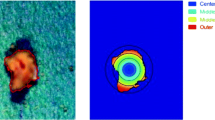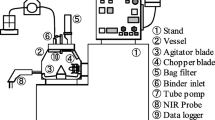Abstract
This study describes a novel approach for the use of thermal analysis to study the aftermath of the fluid bed melt granulation process and to depict the growth mechanism of the granules by quantifying the enthalpies of the granules at every physicochemical change using DSC and their mass loss through TG coupled to MS for a qualitative determination of the composition and amount of the evolved gases for the corresponding fragment ion. The experiments were made in situ with lactose monohydrate and two viscosity grades of PEG (2000 and 6000) as meltable binders with different contents and size fractions. DSC showed the presence of a beta lactose endotherm peak after the melting of alpha lactose and a proportional increase in its intensity with the increase in the particle size and the content of the binder, which suggested a relation with the agglomeration growth. Interestingly, TG and MS showed a larger reduction in the water content from lactose with the increase in the binder particle size, making it possible to evaluate the dehydration during the melt granulation. Indeed, during the distribution mechanism the low binder particle size and viscosity exposed lactose to a high heat transfer from the fluidizing air. However, a high binder particle size results in lactose immersed in the PEG particles, causing water to be trapped inside the granules and hence a larger reduction in water mass loss indicating the immersion mechanism. Therefore, thermal analysis is a promising tool for granulation growth control.







Similar content being viewed by others
References
Szűts A, Sorrenti M, Catenacci L, Bettinetti G, Szabó-Révész P. Investigation of the thermal and structural behavior of diclofenac sodium–sugar ester surfactant systems. J Therm Anal Calorim. 2009;95:885–90.
Sekiguchi K, Obi N. Studies on absorption of eutectic mixtures. I. A comparison of the behavior of eutectic mixtures of sulfathiazole and that of ordinary sulfathiazole in man. Chem Pham Bull. 1961;9:866–87.
Maniruzzaman M, Boateng JS, Snowden MJ, Douroumis D. A review of hot-melt extrusion: process technology to pharmaceutical product. ISRN Pharm. 2012;. https://doi.org/10.5402/2012/436763.
Monteyne T, Heeze L, Mortier STFC, Oldörp K, Cardinaels R, Nopens I, Vervaet C, Remon JP, De Beer T. The use of rheology combined with differential scanning calorimetry to elucidate the granulation mechanism of an immiscible formulation during continuous twin-screw melt granulation. Pharm Res. 2016;510:271–84.
Roumeli E, Tsiapranta A, Pavlidou E, Vourlias G, Kachrimanis K, Bikiaris D, Chrissafis K. Compatibility study between trandolapril and natural excipients used in solid dosage forms. J Therm Anal Calorim. 2013;111:2109–15.
Ansari MA, Stepanek F. Formation of hollow core granules by fluid bed in situ melt granulation: modelling and experiments. Int J Pharm. 2006;321:108–16.
Kidokoro M, Sasaki K, Haramiishi Y, Matahira N. Effect of crystallization behavior of polyethylene glycol 6000 on the properties of granules prepared by fluidized hot-melt granulation (FHMG). Chem Pham Bull. 2003;51:487–93.
Mangwandi C, Zainal NA, JiangTao L, Glocheux Y, Albadarin AB. Investigation of influence of process variables on mechanical strength, size and homogeneity of pharmaceutical granules produced by fluidised hot melt granulation. Powder Technol. 2015;272:173–80.
Prado HJ, Bonelli PR, Cukierman AL. In situ fluidized hot melt granulation using a novel meltable binder: effect of formulation variables on granule characteristics and controlled release tablets. Powder Technol. 2014;264:498–506.
Zhai H, Li S, Andrews G, Jones D, Bell S, Walker G. Nucleation and growth in fluidized hot melt granulation. Powder Technol. 2009;189:230–7.
Mašić I, Ilić I, Dreu R, Ibrić S, Parojčić J, Đurić Z. An investigation into the effect of formulation variables and process parameters on characteristics of granules obtained by in situ fluidized hot melt granulation. Int J Pharm. 2012;423:202–12.
Mašić I, Ilić I, Dreu R, Ibrić S, Parojčić J, Srčič S. Melt granulation in fluidized bed: a comparative study of spray-on versus in situ procedure. Drug Dev Ind Pharm. 2014;40:23–32.
Walker GM, Holland CR, Ahmad MMN, Craig DQM. Influence of process parameters on fluidised hot-melt granulation and tablet pressing of pharmaceuticals powders. Chem Eng Sci. 2005;60:3867–77.
Mu B, Thompson MR, Sheskey PJ, O’Donnell KP. Hot-melt granulation in a twin-screw extruder. Chem Eng Sci. 2012;81:46–56.
Weatherley S, Mu B, Thompson MR, Sheskey PJ, O’Donnell KP. Hot-melt granulation in a twin screw extruder: effects of processing on formulations with caffeine and ibuprofen. J Pharm Sci. 2013;102:4330–6.
Giron D, Goldbronn C. Use of DSC and TG for identification and quantification of the dosage form. J Therm Anal. 1997;48:473–83.
Vasanthavada M, Wang Y, Haefele T, Lakshman JP, Mone M, Tong W, Joshi YM, Serajuddin ATM. Application of melt granulation technology using twin-screw extruder in development of high-dose modified-release tablet formulation. J Pharm Sci. 2011;100:1923–34.
Giron D. Thermal analysis and calorimetric methods in the characterisation of polymorphs and solvates. Thermochim Acta. 1995;248:1.
Ozawa T. Thermal analysis—review and prospect. Thermochim Acta. 2000;355:5–42.
Reitz C, Kleinebudde P. Influence of thermal and thermo-mechanical treatment, Comparison of two lipids with respect to their suitability for solid lipid extrusion. J Therm Anal Calorim. 2007;89:669–73.
Mojumdar SC, Sain M, Prasad RC, Sun L, Venart JES. Selected thermoanalytical methods and their applications from medicine to construction. J Therm Anal Calorim. 2007;90:653–62.
Gombás Á, Szabó-Révész P, Kata M, Regdon G Jr, Erős I. Quantitative determination of crystallinity of α-lactose monohydrate by DSC. J Therm Anal Calorim. 2002;68:503–10.
Jayaraman K, Kok MV, Gokalp I. Combustion properties and kinetics of different biomass samples using TG–MS technique. J Therm Anal Calorim. 2017;127:1361–70.
Wang Z, Li H, Zheng J. TG–MS study on the effect of multi-walled carbon nanotubes and nano-Fe2O3 on thermo-oxidative stability of silicone rubber. J Therm Anal Calorim. 2016;126:733–42.
Li S, Yang C, Li C, Yan S. Synthesis, characterization of new bisphenol-based benzoxazines and the thermal properties of their polymers. J Therm Anal Calorim. 2017;128(3):1711–7.
Zohari N, Abrishami F, Sheibani N. A novel simple correlation for predicting glass transition temperature of energetic azido-ester plasticizers through molecular structures. J Therm Anal Calorim. 2017;127:2243–51.
Hotová G, Slovác V. Quantitative TG–MS analysis of evolved gases during the thermal decomposition of carbon containing solids. Thermochim Acta. 2016;632:23–8.
Esfe MH. Designing an artificial neural network using radial basis function (RBF-ANN) to model thermal conductivity of ethylene glycol–water-based TiO2 nanofluids. J Therm Anal Calorim. 2017;127:2125–31.
Esfe MH, Rejvani M, Karimpour R, Arani AAA. Estimation of thermal conductivity of ethylene glycol-based nanofluid with hybrid suspensions of SWCNT-AL2O3 nanoparticles by correlation and ANN methods using experimental data. J Therm Anal Calorim. 2017;128:1359–71.
Kullyakool S, Siriwong K, Noisong P, Danvirutai C. Kinetic triplet evaluation of a complicated dehydration of (CO4)2·8H2O using the deconvolution and the simplified master plots combined with nonlinear regression. J Therm Anal Calorim. 2017;127:1963–74.
Çepelioğullar Ö, Mutlu I, Yaman S, Haykiri-Acma H. A study to predict pyrolytic behaviors of refuse-derived fuel (RDF): artificial neural network application. J Anal Appl Pyrolysis. 2016;122:84–94.
Raut DM, Allada R, Pavan KV, Deshpande G, Patil D, Patil A, Deshmukh A, Sakharkar DM, Bodke PS, Mahajan DT. Dehydration of lactose monohydrate: analytical and physical characterization. Der Pharma Lett. 2011;3:202–12.
Acknowledgements
The authors would like to thank the Ministry of Higher Education and Scientific Research of Algeria and the Tempus Public Foundation for the Stipendium Hungaricum scholarship provided to Yasmine Korteby for her PhD studies.
Author information
Authors and Affiliations
Corresponding author
Rights and permissions
About this article
Cite this article
Regdon, G., Korteby, Y. Quantitative and qualitative use of thermal analysis for the investigation of the properties of granules during fluid bed melt granulation. J Therm Anal Calorim 133, 619–632 (2018). https://doi.org/10.1007/s10973-017-6848-5
Received:
Accepted:
Published:
Issue Date:
DOI: https://doi.org/10.1007/s10973-017-6848-5




